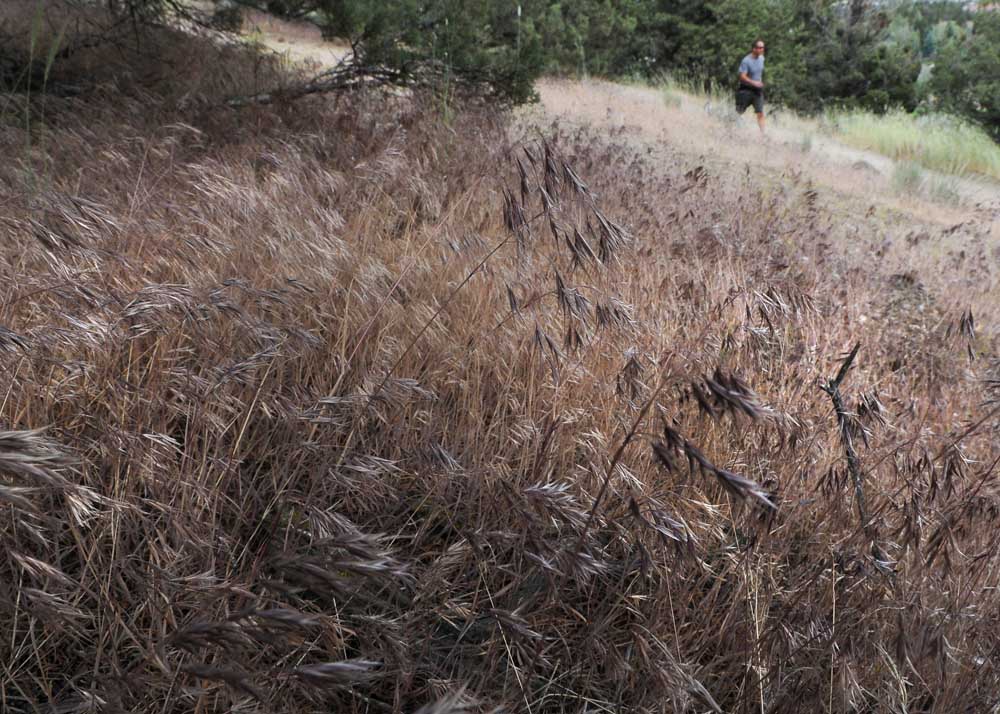Cheatgrass returns to Central Oregon
Published 5:03 pm Wednesday, June 21, 2017

- A walker passes a large area of cheatgrass growing along the Pilot Butte trail system on Thursday. The invasive grass has grown in thicker and taller this year due to the wetter winter and spring around Central Oregon. (Ryan Brennecke/Bulletin photo)
With summer officially here, the invasive weed commonly known as cheatgrass is back and taller than ever, leaving federal and county forestry officials concerned that the outbreak could lead to more wildfires.
Cheatgrass, recognizable by its drooping, wheat-like seed heads, is nothing new to longtime Central Oregonians, and is common throughout the Western United States. This year, however, a wet winter and spring has led to taller, thicker patches of the grass, according to Deschutes County Forester Ed Keith.
“I’m certainly seeing plenty of it,” Keith said.
While cheatgrass is mainly regarded as a nuisance to pets and people in Central Oregon, the invasive weed can help wildfires begin and spread rapidly, thanks in part to its tendency to grow near roadways. The taller the grass, the more likely it is to catch a spark from a running car, according to Alex Robertson, fire and aviation staff officer for Central Oregon Fire Management Service, an interagency organization that handles wildfire control in Central Oregon.
“It’s such a hard problem to deal with,” Robertson said.
The invasive plant has seed heads that can easily get lodged in boots, tires and clothing, which spreads it to other locations and causes problems for the hosts. In some cases, Keith said seeds can get lodged in the ears of pets, requiring costly surgery to remove. Sarah Callaghan, invasive plant program manager for the Deschutes and Ochoco National Forests, encourages visitors to the forests to check their clothes and cars for grass seeds before leaving, to avoid transferring the grass to new spots.
The real impact of cheatgrass can be felt each year once fire season rolls around. Robertson said the invasive species dries out about a month earlier than native grasses. The stalks turn from green in April and May, to purple, to yellowish brown once summer sets in. Once it’s dry, it becomes very flammable, turning into low-lying tinder for forest fires, Robertson said.
“(Other) fuels determine the intensity and longevity of a fire,” he said. “But the grass will determine whether or not it spreads.”
Cheatgrass dies off every year and sprouts anew during December and January, but Keith said the height and density of cheatgrass patches depends how wet the winter and spring are. In 2017, the heavy snow and rain in the region produced taller, denser patches across Central Oregon, particularly in relatively wet, low-elevation portions of Central Oregon.
“This is the thickest we’ve seen it in years,” Callaghan said.
While Robertson said the grass normally doesn’t get much taller than 10 inches in the region, he’s seen much taller patches so far this year.
“You can look around and see cheatgrass that’s above your knee,” he said.
Robertson added that the grass does well in disturbed habitats, including fire scars and areas alongside roadways. Because of that, it can easily provide tinder for fires. As the grass grows, it gets closer to ignition sources on cars, like hot tailpipes. Drivers that pull off to the side of the road can ignite dry grass.
“You can see the stacking of problems here,” Robertson said.
Several Central Oregon fires have begun with sparks from cars hitting dry roadside grasses, including the County Line 2 fire, which burned more than 67,000 acres on the Warm Springs Indian Reservation in 2015, according to The Bulletin’s archives.
Additionally, cheatgrass’ abundance makes it more of a challenge to contain and eradicate, particularly in disturbed environments where it can out-compete other plants. Other than intermediately pulling the grass out by hand, the U.S. Forest Service typically leaves cheatgrass alone, Callaghan said. Keith added that Deschutes County classifies cheatgrass as a class-C noxious weed, the lowest priority, in part because it’s so prevalent. He said he talks to landowners about how to manage growth on their properties, but doesn’t focus on removing it.
“If we started to fund cheatgrass (reduction) projects, we’d run out of money yesterday,” Keith said.
Keith said applying pre-emergent herbicides in the fall can yield positive results in the spring. He added that planting native vegetation around it can help edge it out of an environment.
Cheatgrass doesn’t have a deep root system, making it easy to pull if it’s detected before the seeds drop. To that end, events like Let’s Pull Together, the 14-year-old event held earlier this month that brings together volunteers to pull cheatgrass and other noxious weeds in Bend, can help manage their spread.
“If people don’t get it pulled, they’ll deal with it again next year,” Keith said.
—Reporter: 541-617-7818, shamway@bendbulletin.com








